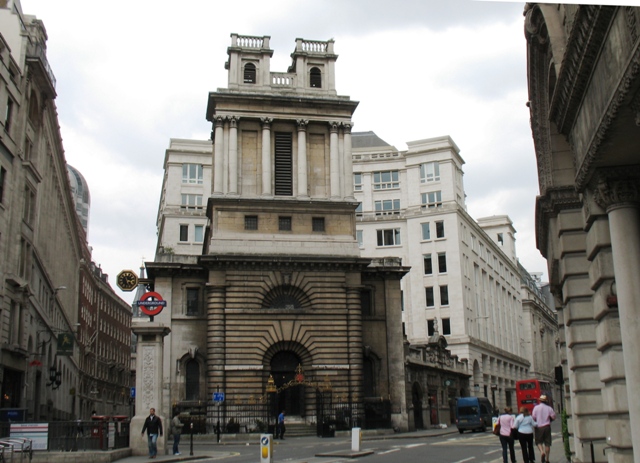St Mary Woolnoth (City of London)
Brief Description
The site may once have been that of an ancient pre-Christian temple, fragments of which were discovered in 1716 when St Mary's was rebuilt. Possibly named after someone called Wulfnoth, although other explanations are that it was so-called to distinguish it from St Mary Woolchurch, a nearby church destroyed in the Great Fire in whose churchyard there was a beam for weighing wool, Woolnoth derived from Wool-nought. The church was rebuilt by Nicholas Hawskmoor in the early C18th. For many years the rector was Revd John Newton, friend of the poet William Cowper, and he was buried in a vault in the church in 1807. The crypt was later used as the booking hall for the new Bank station built alongside the church in 1897. In front of the church entrance is a small semi-circular paved forecourt with some planting and seating, bordered by fine railings.
Practical Information
- Previous / Other name:
- St Mary the Nativity
- Site location:
- Lombard Street/King William Street
- Postcode:
- EC3V 9AN
- What 3 Words:
- headed.flops.struck
- Type of site:
- Churchyard
- Borough:
- City of London
- Open to public?
- Yes
- Opening times:
- Church: Mon-Fri 9.30am-4.30pm
- Special conditions:
- Facilities:
- Events:
- Public transport:
- Tube: Bank (Central, DLR, Northern, Waterloo & City) / Monument (Circle, District)
- Research updated:
- 01/06/2010
- Last minor changes:
- 14/07/2022
Please check with the site owner or manager for latest news. www.london.anglican.org
Full Site Description
The site may once have been that of an ancient pre-Christian temple, fragments of which were discovered in 1716 when St Mary's was rebuilt. Possibly named after someone called Wulfnoth, although other explanations are that it was so called to distinguish it from St Mary Woolchurch, a nearby church destroyed in the Great Fire in whose churchyard was a beam for weighing wool, Woolnoth derived from Wool-nought. St Mary Woolnoth is first referred to in 1273/4. The church belonged to the Priory of St Helen Bishopsgate until the Dissolution of the Monasteries, its first lay patron thereafter was Sir Martin Bowes, Master of the Goldsmiths' Company. An older church was rebuilt c.1438 and a charnel chapel was built in 1496 and was used for burials. The church was badly damaged in the Fire of London but in 1677 St Mary Woolnoth was only repaired by Wren. This work was paid for largely by Alderman Sir Robert Vyner, who lived nearby in Lombard Street and in recognition of this munificence, according to John Stow, a number of vines were placed over that part of the church facing his house. After the Fire the parish was joined by that of St Mary le Stocks near the site of Mansion House, which was destroyed and not rebuilt. However, St Mary Woolnoth became dilapidated and following the Fifty New Churches Act of 1711, it was rebuilt by Nicholas Hawksmoor in 1716-27. For many years the rector was Revd John Newton, friend of the poet William Cowper, and he was buried in a vault in the church in 1807. The iron railings date from c1900, and were extended c.1992.
The crypt of the church was once used as a booking hall for Bank underground station, which was built alongside the church on King William Street in 1897/8. In 2004 works were undertaken as part of adjacent development and a passageway behind the church was opened. There is a small semi-circular paved forecourt with some planting and seating, bordered by railings with fine gates and gate piers.
Sources consulted:
Simon Bradley & Nikolaus Pevsner, 'The Buildings of England, London 1: The City of London', 1997 (1999 ed.); George Godwin & John Britton 'The Churches of London: A history and description of the Ecclesiastical Edifices of the Metropolis, Volume II', London, 1839; Philip Norman, 'The London City Churches, Their Use, Their Preservation and Their Extended Use', The London Society, (1920s); London Diocesan Advisory Committee for the Care of Churches data
Further Information (Planning and Conservation)
- Grid ref:
- TQ327810 (532768,181050)
- Size in hectares:
- 0.0089
- Site ownership:
- Diocese of London
- Site management:
- Church (except window boxes maintained by City of London Corporation Open Spaces Dept.)
- Date(s):
- C13th; 1716-27; 1890s
- Designer(s):
- Nicholas Hawksmoor (Church 1716-27))
- Listed structures:
- LBI: St Mary Woolnoth Church. LBII: Gate piers and gates to church
- On National Heritage List for England (NHLE), Parks & Gardens:
No- Registered common or village green on Commons Registration Act 1965:
No- Protected under London Squares Preservation Act 1931:
No
Local Authority Data
The information below is taken from the relevant Local Authority's planning legislation, which was correct at the time of research but may have been amended in the interim. Please check with the Local Authority for latest planning information.
- On Local List:
- No
- In Conservation Area:
- Yes
- Conservation Area name:
- Bank
- Tree Preservation Order:
- No
- Nature Conservation Area:
- No
- Green Belt:
- No
- Metropolitan Open Land:
- No
- Special Policy Area:
- No
- Other LA designation:
- None
Please note the Inventory and its content are provided for your general information only and are subject to change. It is your responsibility to check the accuracy.







